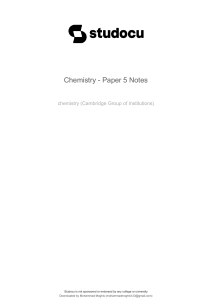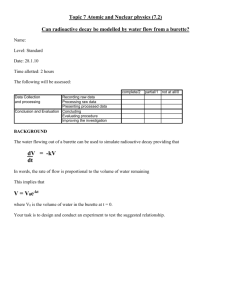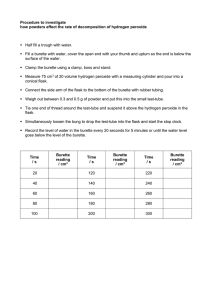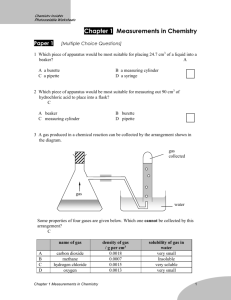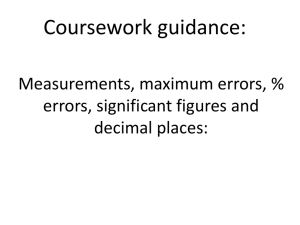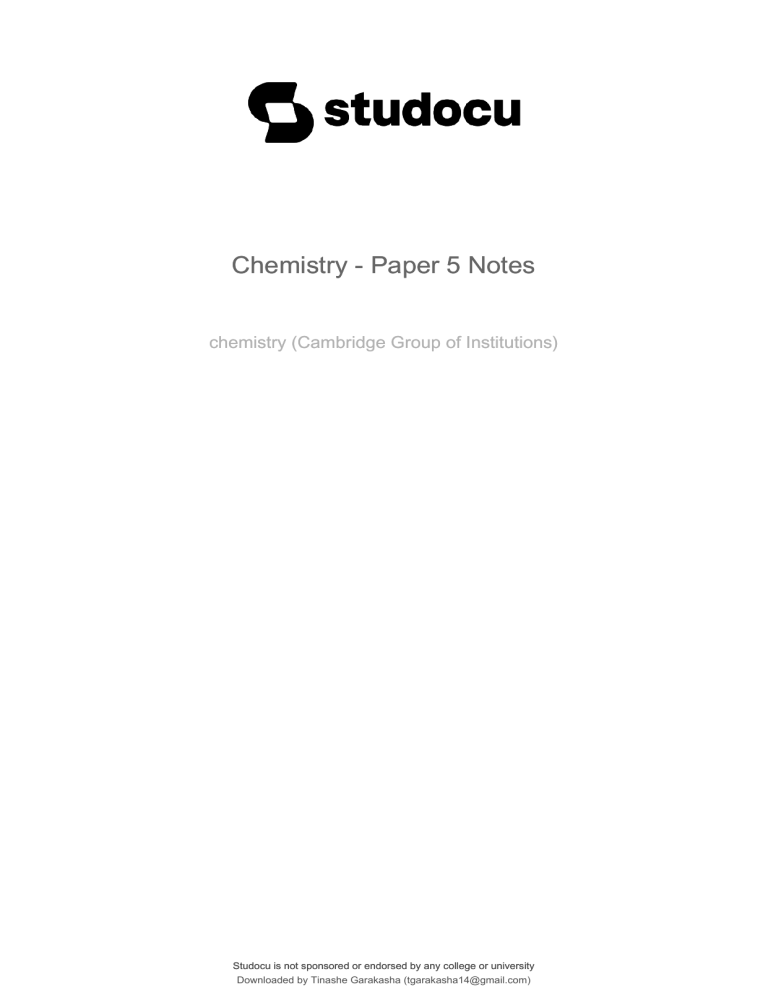
lOMoARcPSD|12168090 Chemistry - Paper 5 Notes chemistry (Cambridge Group of Institutions) Studocu is not sponsored or endorsed by any college or university Downloaded by Tinashe Garakasha (tgarakasha14@gmail.com) lOMoARcPSD|12168090 CHEMISTRY PAPER 5 – NOTES LIFE SAVING KNOWLEDGE To ensure that drying process for a solid is complete, heat to constant mass. This ensures all water has been evaporated. Since alcohols are highly flammable, it is dangerous to heat them on a naked flame. Always use a water bath to heat alcohols and mixtures containing alcohols CO2 and O2 are water soluble gases (oxygen is only slightly soluble) To increase reliability, repeat experiment trial multiple times and take average reading Give burette readings to the nearest 0.05 cm3, since burette can only measure up to ± 0.05 cm3. It cannot take readings more accurate than this. In electrolysis, some deposited metal could possibly fall off the electrode while washing it, leading to a lower reading of mass than expected. While weighing a mass to prepare standard solution, weigh a larger mass to reduce percentage error and make experiment more accurate. Always use distilled water in experiments since tap water may contain dissolved ions which alter its boiling point and may interfere with experimental results To keep temperature of a solution constant, place it in a thermostatically controlled water bath If a heated solution is left without a lid, water may evaporate, changing the concentration of reactants In any condenser, cold water always enters at the bottom To control exothermic reactions, add reactants dropwise. Certain reaction enthalpies cannot be measured directly since it is impossible to know when the reaction is complete. Before starting an experiment where temperature is measured, allow system to equilibrate and reach the same temperature In an experiment where temperature is measured, stirring the mixture will make results more reliable since this ensures uniform heating of solution Initial trial experiments are often done to calibrate instruments When asked how one variable varies with respect to another, answer in terms of directly/inversely proportional Soda lime (mixture of CaO and Ca(OH)2) is alkaline in nature When a hot solid is being made to react with a gas, the gas may be passed over it before the solid is begun to be heated and after it has finished reacting. This is to prevent the solid from reacting with other gases in air. Instruments must be wiped to ensure they are clean and dry to prevent water/dirt does not interfere with readings During titration, ensure that titre readings are concordant. If they are not consistent/close to each other, repeat titration until concordant readings are obtained. Downloaded by Tinashe Garakasha (tgarakasha14@gmail.com) Page 1 of 7 lOMoARcPSD|12168090 If indicator and one of the reactants used is the same colour, change the indicator to one which displays a different colour to improve the accuracy of results. When taking volume measurements use lower meniscus for liquids with concave meniscus, and upper meniscus for liquids with convex meniscus To eliminate anomalous readings, repeat the experiment for those values. While doing enthalpy change experiments, it is important to measure the temperature before and after the reaction. In a decomposition reaction, if heating is very strong, time measurement will be very small, increasing the percentage error and reducing accuracy of reaction. At the same time, underheating may not ensure that all of the solid has decomposed. Downloaded by Tinashe Garakasha (tgarakasha14@gmail.com) Page 2 of 7 lOMoARcPSD|12168090 APPARATUS SETUP FILTRATION UNDER REDUCED PRESSURE FRACTIONAL DISTILLATION A vacuum in the flask underneath the paper allows atmospheric pressure on the sample to force the liquid through the filter paper. Liquid with lower boiling point is collected first IMPORTANT: The bulb of the thermometer should be at the front of the tube opening where the gas leaves the fractionating column. Advantage – faster filtration COLLECTING GAS OVER WATER COLLECTING GAS IN A GAS SYRINGE - Gas should not be water soluble - Inverted measuring cylinder should be fully filled with water at the beginning of the experiment - Never use first sample of gas since this may contain air from apparatus and not just pure gas - Never use first sample of gas from a reaction since this may contain air from apparatus and not just pure gas Risk of suck back – the creation of a vacuum/region of low pressure in the container due to collection of gas over water causes the water to be sucked back into the reaction container, which is not desirable Downloaded by Tinashe Garakasha (tgarakasha14@gmail.com) Page 3 of 7 lOMoARcPSD|12168090 SETUP FOR ELECTROLYSIS PERFORMING A REACTION UNDER REFLUX Don’t put a bung at the top of the condenser since heating causes gases to expand. So the pressure would build up, causing the apparatus to shatter. Reflux is used to heat mixture to a. Increase rate of reaction b. Prevent loss of vapour Measuring temperature change of a reaction COLLECTING A CONDENSED GAS FROM A REACTION Stir the liquid if possible with the thermometer to ensure accurate readings Allows collection of gases with different boiling points (kind of reverse of fractional distillation) Insulate beaker to prevent heat loss Gas with lower boiling point will condense first, other gas will escape. Must leave other end of U tube open to prevent pressure build up. Downloaded by Tinashe Garakasha (tgarakasha14@gmail.com) Page 4 of 7 lOMoARcPSD|12168090 FREQUENT FLIERS Steps to make a standard solution: 1. Add known mass of solid to a beaker and dissolve it in distilled water (if starting compound is liquid, transfer known volume of liquid to volumetric flask directly using funnel, then add washings of funnel to flask) 2. Transfer solution to a volumetric flask (100 cm3, 250cm3, 500cm3 as appropriate) 3. Wash beaker with some distilled water and add washings to the flask 4. Fill flask up to the mark with distilled water and shake thoroughly Steps to accurately measure the mass of a solid transferred to another container: 1. 2. 3. 4. 5. Add some mass of a substance to a weighing boat Weigh the mass of substance + weighing boat (W1) Transfer the substance to another container/beaker Weigh the mass of weighing boat after transfer is done (W2) Calculate mass of substance transferred using W1 – W2 Note: don’t reverse the order of weighing since some of the substance might remain in the boat as a residue after the transfer, giving an inaccurate reading of mass transferred Justifying why results are reliable: - Because measurements are close to each other Because all points lie either on or very close to the line of best fit Because there are no anomalous points POTENTIAL TRIPPING HAZARDS While filling a burette: 1. 2. 3. 4. Run some distilled water through the burette to ensure it is clean Run some of the liquid you intend to fill through the burette, to remove any of the water in it Fill burette using a funnel Open the tap and run some liquid through the tap to eliminate any air bubbles in the liquid column How to know when reaction is complete: 1. Colour change of indicator/reactants/products 2. No more bubbles seen 3. No more mass increase seen 4. Temperature reaches its max and then starts to fall (for exothermic reactions) 5. Temperature reaches its minimum and then starts to rise (for endothermic reactions) Terms used to describe observations: - Colourless (not transparent or clear): used to describe a solution that looks like water Precipitate: describes small pieces of solid mixed with a liquid or solution Gelatinous precipitate: a precipitate that looks like jelly Effervescence: describes the formation of bubbles Downloaded by Tinashe Garakasha (tgarakasha14@gmail.com) Page 5 of 7 lOMoARcPSD|12168090 Possible observations of reactions: 1. Solid/precipitate formed (if coloured then mention colour) 2. Solid disappears (if it reacts/dissolves in liquid) 3. Solid remains (if no visible change occurs to the solid) 4. Coloured gas evolved (mention colour) 5. Bubbles of gas/Effervescence 6. Gas relights glowing splint (Oxygen) 7. Gas extinguishes glowing splint/Gas turns lime water milky (Carbon Dioxide) 8. Brown gas evolved (NO2) 9. Condensation (H2O) formed on sides of test tube (dehydration of hydrated salt) 10. Gas turns damp red litmus blue (Ammonia) 11. Gas smells of bad eggs (H2S – it is also flammable) 12. Gas bleaches litmus paper white (Chlorine) Apparatus use: 1. Burette: to measure volume accurately 2. Digital probe thermometer: to show accurate temperature changes (more accurate than lab thermometer) 3. Glass rod stirrer: to stir solutions (for example, while being heated to ensure uniform heating) 4. Thermostatically controlled water bath: to control/maintain the temperature of a sample or a reaction ERRORS, UNCERTAINTIES & PRECAUTIONS Systematic error: measurement errors caused by measurements differing from the true value by a consistent amount for each measurement that is made. Random error: measurement error caused by measurements varying unpredictably from one measurement to the next Sources of error (examples): 1. Heat loss in experiments where enthalpy is being measured (not all heat from heater is transferred to reaction mixture/some heat produced in reaction is lost to surroundings) 2. In some titrations, it is difficult to judge the end point of the reaction since colour changes may be subjective/difficult to discern 3. Insufficient capacity of apparatus may cause reactants to splash out/escape (e.g: filling a beaker to the very brim) To make readings more precise/accurate: 1. Changes in apparatus: use burette instead of measuring cylinder, use thermocouple instead of lab thermometer, use pH meter instead of pH paper 2. Repeating readings to identify and eliminate anomalies and make results more reliable 3. Performing experiments with larger quantities of reactants, to reduce percentage error 4. Changes in method: using weighing boat method to measure mass transferred, using lower meniscus for accurate volume measurements Downloaded by Tinashe Garakasha (tgarakasha14@gmail.com) Page 6 of 7 lOMoARcPSD|12168090 Calculating percentage error/uncertainty If the least count of a burette is 0.1 cm3 then the uncertainty/error in measurements could be ±0.05 cm3 Uncertainty is ± half of the smallest scale division of an instrument. If this burette is used to measure a change in volume of 20 cm3, that means that volume is being read twice – initial volume and final volume. Thus, to find percentage uncertainty: % ăĀ�㕐ÿĀĂ�㕎�㕖ĀĂ�㕦 = % ăĀ�㕐ÿĀĂ�㕎�㕖ĀĂ�㕦 = 0.05 × 2 × 100 20 ăĀ�㕐ÿĀĂ�㕎�㕖ĀĂ�㕦 × Āā. āĀ Ă�㕖ÿÿā ÿÿ�㕎āăĀÿÿÿĀĂ �㕖ā Ă�㕎�㕘ÿĀ ăā�㕖Āā �㕖ĀāĂĀăÿÿĀĂ × 100 ÿÿ�㕎āăĀÿÿÿĀĂ āĀ ÿă�㕎ĀĂ�㕖Ă�㕦 Precautions and Safety Measures 1. Wear gloves while handling chemicals that can cause skin irritation or while handling heated apparatus 2. Do not dispose solutions which are toxic to aquatic life/pose environmental hazards down the sink 3. Keep alcohols and flammable compounds away from naked flames 4. In experiments in which toxic gases are evolved that pose a health hazard, perform experiment in fume cupboard 5. Wear a mask while performing experiments where compounds are harmful by inhalation/if swallowed 6. Use insulation while performing an experiment involving temperature changes being measured 7. Ensure that instruments have no zero error. If a zero error exists, be sure to add/subtract the error as appropriate to avoid systematic error Downloaded by Tinashe Garakasha (tgarakasha14@gmail.com) Page 7 of 7
